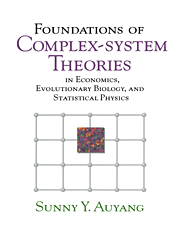Book contents
8 - Complexity in the Temporal Dimension
Published online by Cambridge University Press: 11 May 2010
Summary
Deterministic Dynamics: State-space Portraits
Dynamic systems are things undergoing processes. This and the following chapter examine two classes of processes and three mathematical theories applicable to them. Deterministic processes are governed by dynamic rules represented by differential equations (§§ 29–31). Stochastic processes are treated by theories that make use of the probability calculus but do not mention dynamic rules (§§ 35–38). A dynamic process can be characterized deterministically in a fine-grained description and stochastically in a coarsegrained description. Both characterizations are included in the ergodic theory, which employs both dynamic rules and statistical concepts (§§ 32–33). The mathematics that unites deterministic and stochastic concepts in a single dynamic system exposes the irrelevancy of the metaphysical doctrines of determinism and tychism (the dominion of chance) (§§ 34, 39).
A deterministic process follows a dynamic rule that specifies a unique successor state for each state of the system undergoing the process. The rulegoverned change makes the behaviors of deterministic systems predictable and controllable to a significant extent. In recent decades, high-speed digital computers have enabled scientists to study dynamic systems previously deemed too difficult, notably nonlinear systems. Some of these systems exhibit chaotic behaviors that are unpredictable in the long run, because the slightest inaccuracy in the initial state is amplified exponentially, so that the error eventually overwhelms the result of the dynamic rule.
Stochastic processes are represented by distribution functions that give the number of stages in a process having certain characters.
- Type
- Chapter
- Information
- Foundations of Complex-system TheoriesIn Economics, Evolutionary Biology, and Statistical Physics, pp. 228 - 268Publisher: Cambridge University PressPrint publication year: 1998



